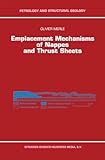Emplacement mechanisms of nappes and thrust sheets [Libro electrónico] / Olivier Merle
Por: Merle, Olivier [autor/a].
Tipo de material: Libro
en línea Editor: Dordrecht: Springer science, c1998Descripción: viii, 159 páginas : gráf., ilustraciones, mapas ; centímetros.ISBN: 9048149673; 9789048149674; 9789401590600 (Online).Nota de acceso: Disponible para usuarios de ECOSUR con su clave de acceso Nota de bibliografía: Incluye bibliografía: páginas 135-149 e índice: páginas 51-159 Número de sistema: 57349Resumen:
Libro
en línea Editor: Dordrecht: Springer science, c1998Descripción: viii, 159 páginas : gráf., ilustraciones, mapas ; centímetros.ISBN: 9048149673; 9789048149674; 9789401590600 (Online).Nota de acceso: Disponible para usuarios de ECOSUR con su clave de acceso Nota de bibliografía: Incluye bibliografía: páginas 135-149 e índice: páginas 51-159 Número de sistema: 57349Resumen:| Tipo de ítem | Biblioteca actual | Colección | Signatura | Estado | Fecha de vencimiento | Código de barras |
|---|---|---|---|---|---|---|
| Libros | Biblioteca Electrónica Recursos en línea (RE) | Acervo General | Recurso digital | ECO400573497719 |
Incluye bibliografía: páginas 135-149 e índice: páginas 51-159
Disponible para usuarios de ECOSUR con su clave de acceso
Nappes and overthrusts are the mosl representative geological structures in mountain chains. The issue of their emplacement mechanisms and of the driving force of these displacements is a major problem in tectonics which interests, for near to a century now and not without harsh controversies, a significant proportion of structural geologists and geoscientists who work in the field of rock mechanics. This book attempts to give a clear and didactic synthesis of the current knowledge of the concept of thrusting, principally by tackling two approaches, mechanics and kinematics, which have proposed some solutions to this problem. At first (Chapter I), the notions of thrusting are defined, with the most recent terminology and the most important geometric aspects. This introduction to the geometry of thrusts is logically followed by the presentation of their problem; the issue of the emplacement mechanisms (Chapter 2). Let us note in passing that the formulation of the concept and the presentation of its problem are associated historically, which justifies presenting them in the historical framework of this discovery before tackling the different solutions and mechanical hypotheses. These are detailed in Chapter 3 by following a chronological progression, and emphasising the divergences and oppositions between different models so as to cover them fully. The chapter on the kinematics (Chapter 4) then returns to the type of data which can be collected in the field, by clarifying the relationships between displacement and internal strain. eng
Disponible en línea
Disponible en formato PDF
Subscripción a ELSEVIER 26 de diciembre del 2013
